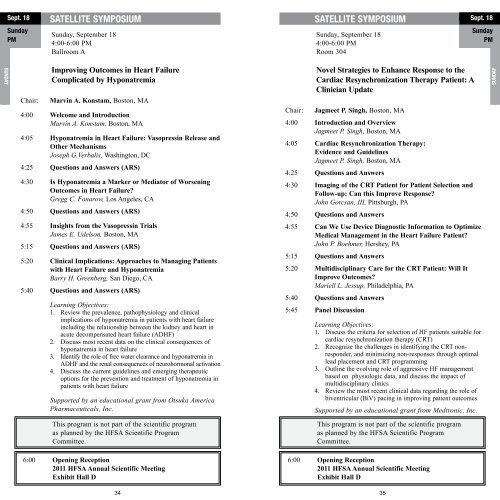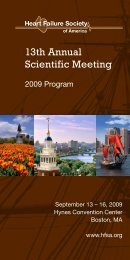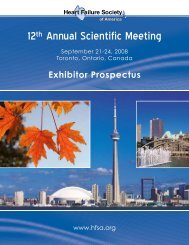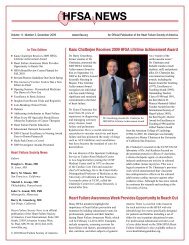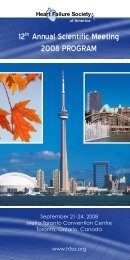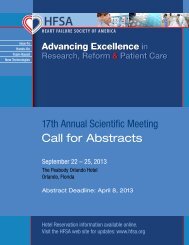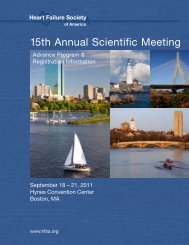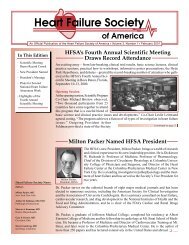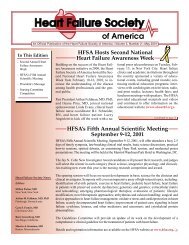15th Annual Scientific Meeting - Heart Failure Society of America
15th Annual Scientific Meeting - Heart Failure Society of America
15th Annual Scientific Meeting - Heart Failure Society of America
Create successful ePaper yourself
Turn your PDF publications into a flip-book with our unique Google optimized e-Paper software.
Sept. 18<br />
Sunday<br />
PM<br />
SATELLITE SYMPOSIUM<br />
Sunday, September 18<br />
4:00-6:00 PM<br />
Ballroom A<br />
SATELLITE SYMPOSIUM<br />
Sunday, September 18<br />
4:00-6:00 PM<br />
Room 304<br />
Sept. 18<br />
Sunday<br />
PM<br />
sundAY<br />
Chair:<br />
Improving Outcomes in <strong>Heart</strong> <strong>Failure</strong><br />
Complicated by Hyponatremia<br />
Marvin A. Konstam, Boston, MA<br />
4:00 Welcome and Introduction<br />
Marvin A. Konstam, Boston, MA<br />
4:05 Hyponatremia in <strong>Heart</strong> <strong>Failure</strong>: Vasopressin Release and<br />
Other Mechanisms<br />
Joseph G.Verbalis, Washington, DC<br />
4:25 Questions and Answers (ARS)<br />
4:30 Is Hyponatremia a Marker or Mediator <strong>of</strong> Worsening<br />
Outcomes in <strong>Heart</strong> <strong>Failure</strong>?<br />
Gregg C. Fonarow, Los Angeles, CA<br />
4:50 Questions and Answers (ARS)<br />
4:55 Insights from the Vasopressin Trials<br />
James E. Udelson, Boston, MA<br />
5:15 Questions and Answers (ARS)<br />
5:20 Clinical Implications: Approaches to Managing Patients<br />
with <strong>Heart</strong> <strong>Failure</strong> and Hyponatremia<br />
Barry H. Greenberg, San Diego, CA<br />
5:40 Questions and Answers (ARS)<br />
Learning Objectives:<br />
1. Review the prevalence, pathophysiology and clinical<br />
implications <strong>of</strong> hyponatremia in patients with heart failure<br />
including the relationship between the kidney and heart in<br />
acute decompensated heart failure (ADHF)<br />
2. Discuss most recent data on the clinical consequences <strong>of</strong><br />
hyponatremia in heart failure<br />
3. Identify the role <strong>of</strong> free water clearance and hyponatremia in<br />
ADHF and the renal consequences <strong>of</strong> neurohormonal activation<br />
4. Discuss the current guidelines and emerging therapeutic<br />
options for the prevention and treatment <strong>of</strong> hyponatremia in<br />
patients with heart failure<br />
Supported by an educational grant from Otsuka <strong>America</strong><br />
Pharmaceuticals, Inc.<br />
Chair:<br />
Novel Strategies to Enhance Response to the<br />
Cardiac Resynchronization Therapy Patient: A<br />
Clinician Update<br />
Jagmeet P. Singh, Boston, MA<br />
4:00 Introduction and Overview<br />
Jagmeet P. Singh, Boston, MA<br />
4:05 Cardiac Resynchronization Therapy:<br />
Evidence and Guidelines<br />
Jagmeet P. Singh, Boston, MA<br />
4:25 Questions and Answers<br />
4:30 Imaging <strong>of</strong> the CRT Patient for Patient Selection and<br />
Follow-up: Can this Improve Response?<br />
John Gorcsan, III, Pittsburgh, PA<br />
4:50 Questions and Answers<br />
4:55 Can We Use Device Diagnostic Information to Optimize<br />
Medical Management in the <strong>Heart</strong> <strong>Failure</strong> Patient?<br />
John P. Boehmer, Hershey, PA<br />
5:15 Questions and Answers<br />
5:20 Multidisciplinary Care for the CRT Patient: Will It<br />
Improve Outcomes?<br />
Mariell L. Jessup, Philadelphia, PA<br />
5:40 Questions and Answers<br />
5:45 Panel Discussion<br />
Learning Objectives:<br />
1. Discuss the criteria for selection <strong>of</strong> HF patients suitable for<br />
cardiac resynchronization therapy (CRT)<br />
2. Recognize the challenges in identifying the CRT nonresponder,<br />
and minimizing non-responses through optimal<br />
lead placement and CRT programming<br />
3. Outline the evolving role <strong>of</strong> aggressive HF management<br />
based on physiologic data, and discuss the impact <strong>of</strong><br />
multidisciplinary clinics<br />
4. Review the most recent clinical data regarding the role <strong>of</strong><br />
biventricular (BiV) pacing in improving patient outcomes<br />
Supported by an educational grant from Medtronic, Inc.<br />
SundAY<br />
This program is not part <strong>of</strong> the scientific program<br />
as planned by the HFSA <strong>Scientific</strong> Program<br />
Committee.<br />
This program is not part <strong>of</strong> the scientific program<br />
as planned by the HFSA <strong>Scientific</strong> Program<br />
Committee.<br />
6:00 Opening Reception<br />
2011 HFSA <strong>Annual</strong> <strong>Scientific</strong> <strong>Meeting</strong><br />
Exhibit Hall D<br />
6:00 Opening Reception<br />
2011 HFSA <strong>Annual</strong> <strong>Scientific</strong> <strong>Meeting</strong><br />
Exhibit Hall D<br />
34<br />
35


